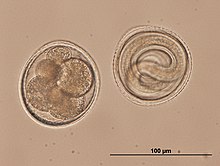Toxocaridae
| Toxocaridae | |
|---|---|
 |
|
| Toxocara embryonated eggs | |
| Scientific classification | |
| Kingdom: | Animalia |
| Phylum: | Nematoda |
| Class: | Secernentea |
| Order: | Ascaridida |
| Family: | Toxocaridae |
| Genera | |
|
See text |
|
See text
The Toxocaridae are a zoonotic family of parasitic nematodes that infect canids and felids and which cause toxocariasis in humans (visceral larva migrans and ocular larva migrans). The worms are unable to reproduce in humans.
Four important species include:
Infection by T. canis or T. cati can cause various clinical manifestations. One of these is visceral larva migrans, wherein the larvae are unable to develop in humans as they do in cats and dogs, their natural hosts. Arrested development leaves the larvae to wander aimlessly in the body, causing inflammation, most commonly in the liver and lungs.
Eggs are introduced into the body through ingestion. This can occur when eggs are deposited on the hands or face, after handling infected dogs or cats. In children without exposure to animals, eggs can be introduced by directly ingesting egg-contaminated soil while playing in a yard or on a playground. Usually, the scenario involves a young child with a new puppy. Unfortunately, many young children who have been infected with these larvae, causing ocular larva migrans in the eye, have been misdiagnosed to have retinoblastoma and have had their eyes erroneously removed.
Direct identification of larvae in human disease is not feasible, so the diagnosis relies on history supported by serologic ELISA assay. The most sensitive assay, called excretory/secretory (E/S), contains 96 immunogenic antigens isolated from cultured T. canis larvae.
A number of products supplied by veterinarians can prevent or treat infections with this parasite. A great deal of information on this subject can be found on the computer sites maintained by the Companion Animal Parasite Council.
...
Wikipedia
